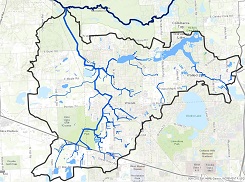About Norton Creek
Norton Creek in Oakland County has 110 miles of branching stream channels, and it drains 24 square miles of land, meaning all the water in this area from the surface and below ground flows into Norton Creek. There are 17 lakes, including Wolverine Lake, 72 ponds, and many wetlands in this creekshed.

Over the last 100 years, Norton creekshed shifted from being rural with farms to a mix of urban and suburban land use. The creek was channelized in many places to support agriculture and much of the land was developed as the population increased. The Huron River Watershed Council conducted an extensive study of the creek from 2014-2016 and identified three main concerns: slow moving water, poor habitat conditions for wildlife, and pollution. In addition, this creek was identified as having increased risk of floods in the future as southeast Michigan experiences larger and more frequent rain events.
Gunnar Mettala Park: Catching Stormwater, Creating Habitat Project, Completed 2023
In partnership with the cities of Wixom and Walled Lake, HRWC redesigned a drainage area in Gunnar Mettala Park into a bioswale which was seeded with native plants. At the Walled Lake Fire House, we transformed a lawn area into a rain garden. Combined, the two projects are expected to catch and soak in over 400,000 gallons of runoff a year (infiltrating it into the groundwater) and reduce phosphorus runoff by over a pound a year and sediment runoff by 588 pounds annually. They also add over 27,000 square feet of GSI and wildlife area in the creekshed.
This project was funded by the National Fish and Wildlife Foundation and the US Fish and Wildlife Service.
Gibson Park: Protecting and Restoring Norton Creek Project, Completed in 2019
In Wixom’s Gibson Park HRWC:
- Restored habitat in the creek to support more natural flows by making a stretch of this artificially straightened creek curvy again. We will do this using simple techniques such as placing large woody debris in the water and anchoring them from the shore.
- Created a bioswale (large ditches with native plants in them) and rain garden along the south side of Pontiac Trail. These features catch water from the road and lawn and remove pollution before it hits the creek.
- Planted shoreline natives to absorb stormwater, prevent erosion and create habitat.
For this project, we worked with Oakland County Water Resources Commissioner’s Office and the City of Wixom, with the support of the Wildlife Conservation Society’s Climate Adaptation Fund and Pure Oakland Water.
Photos from garden planting day on June 8, 2019, thanks to the generous help from local volunteers.
About the restoration techniques
HRWC restored a small section of the creek that was straightened and widened by humans many years ago. An artificially straightened creek causes two problems. First, sediment builds up in the creek because the over-wide channel does not allow the energy of the water’s current to build up and move it downstream. Natural bacteria in the sediment consumes oxygen and chokes oxygen-producing aquatic plants.
Second, without a curvy path to travel along, the creek’s flow doesn’t churn as much. With less tumbling, churning water, less oxygen is delivered to the creek’s water. Without enough oxygen in the water, aquatic insects and animals cannot survive.
We anchored fallen trees and shrubs to the shore and placed them in the water. This natural material is catching sediment and forming new banks to create a narrower “inner channel” with more energy to move sediment and churn-in oxygen. The newer, curvier stream creates a better habitat for a variety of fish and aquatic insects. This improves the health of Norton Creek and the Huron River downstream.
About the native planting techniques
Rain Gardens
Rain gardens capture and filter stormwater runoff before it pollutes creeks and rivers. They also store water and can reduce issues from flooding. They are shallow, saucer shaped gardens planted with deep-rooted native plants and placed where water pools and is directed from roofs and pavement. Rain gardens are easy to maintain, do not require watering, and provide habitat for butterflies and bees.
Bioswales
Bioswales function like rain gardens but are longer in length and usually deeper with engineered soil and rocks to capture and direct larger amounts of water. They are placed along roadsides and very large, paved areas.
Rain Barrels
Gutters on the Gibson House will lead directly to rain barrels that will capture all the water from the roof whenever it rains. Collected water can be used during dry times for watering.
Shoreline Planting
By planting natives along the shoreline near Pontiac Trail, we are protecting the creek. These plants act as a buffer by absorbing some of the stormwater runoff from the road, which can contain automobile fluids, salt, and sediment (dirt).




